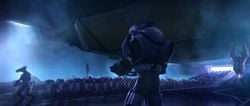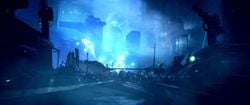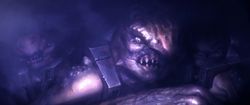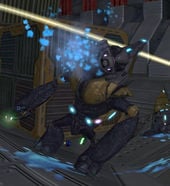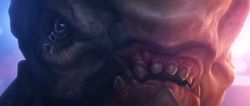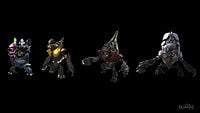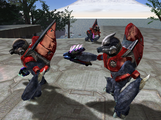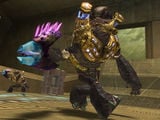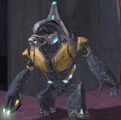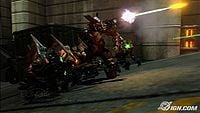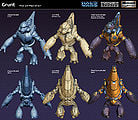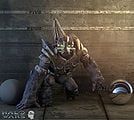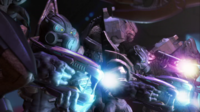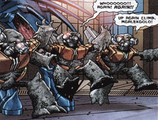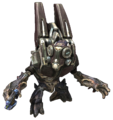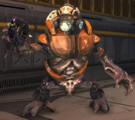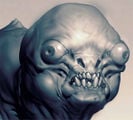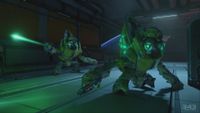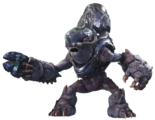Unggoy
From Halopedia, the Halo wiki
- "When in doubt, flee."
- — Unggoy philosophy[1]
The Unggoy[2] (Latin, Monachus frigus, meaning "cold monk") are a sentient species of squat bipedal vertebrates (commonly misidentified as arthropods)[3] from the planet Balaho. The Unggoy were one of the unified races of the Covenant. They were the lowest-ranking species in the hierarchy, and were frequently mistreated by almost every higher-ranking race including the Sangheili, Jiralhanae, and Kig-Yar.
Unggoy were primarily used by the Covenant as laborers or—in combat situations—cannon fodder. They were one of the later races to be introduced into the Covenant, and were one of the first Covenant species to be encountered by humanity. They are referred to as Grunts by humans, mainly because they are considered weak compared to their superiors and also because they perform the majority of the labor required by the Covenant.[4]
History
The Ark and reseeding
Unggoy are believed to have evolved from smaller amphibious primates.[5] Prior to the activation of the Halo Array, the Unggoy had managed to achieve a Tier 4 society on their homeworld, Balaho. However, the planet and the Unggoy civilization was devastated by the collapse of its biosphere due to massive global over-industrialization.[6]
The Unggoy were one of many species indexed by the Librarian for preservation on Installation 00 from the firing of the Halo Array. They were subsequently returned to their homeworld Balaho, where they began re-building their culture.[7]
Induction into the Covenant
In 2142, the Unggoy and their defenseless homeworld were discovered by the Covenant. Most species of the Covenant became incorporated due to faith or mutual beneficence, however the Unggoy were forced into lowly positions within the Covenant through force and aggressive conversion.[5][8] The Unggoy were quickly conquered with little resistance and were the seventh species to be inducted into the empire. The species was quick to become one of the most devoted followers of the Covenant religion and the Great Journey.[9] By the time of their discovery by the Covenant, the Unggoy homeworld was still recovering from its ecological collapse over a hundred millennia earlier, and the Unggoy's Tier 6 civilization had yet to return to its former state.[6]
Being the lowest-ranked species of the Covenant, they are bitter rivals with the Kig-Yar, who are also low-ranked. The higher-ranking races of the Covenant have often ignored this rivalry. The growing Unggoy population on High Charity forced Kig-Yar to relocate their homes to accommodate the Unggoy. The move put stress on Kig-Yar females, which led to an increase in infant mortality, while Unggoy that were forced to share habitats with the Kig-Yar occasionally trampled their nests, inadvertently. The breaking point came when a junior staffer in the Ministry of Concert discovered evidence of the Kig-Yar planning to poison recreational narcotics the Unggoy enjoyed, which would have left them sterile. However, the Minister of Concert and the High Council refused to investigate the matter, as they were willing to accept several thousand sterile Unggoy rather than risk upsetting the Kig-Yar. The rising tensions with the Kig-Yar and the general disinterest from the other Covenant races led to the Unggoy Rebellion in 2462. While the rebellion was ultimately put down thanks to an Arbiter partially glassing Balaho, the Unggoy proved that they were not the cowards they had been long deemed, and could indeed be vicious fighters when provoked. After the uprising's conclusion, as was their tradition, the Sangheili forgave the surviving Unggoy and allowed them to enter the Covenant military as armed infantry units, rather than the unarmed cannon fodder as which they had previously served.[10][11] The Unggoy rebelled several more times in Covenant history, including the Sixteenth Unggoy Disobedience, which was quickly ended by the Ministry of Preservation's Ripa 'Moramee.[12]
Despite the low place they have in the Covenant hierarchy, the true irony is that the Unggoy's entry into the Covenant has ensured their species' survival. Membership in the Covenant granted the Unggoy freedom from risk of extinction during Balaho's two winters, as they now have access to sufficient supplies of food. Infant mortality has decreased to below fifty percent, and geronticide is no longer a necessity for survival. The average life expectancy for non-combatant Unggoy has doubled.[13] Their incorporation into the Covenant likely also alleviated the threat of the Blue Death, which Unggoy typically fear.[14]
Human-Covenant War
The Unggoy were one of the first races in the Covenant to encounter humanity.[15] During the First Battle of Harvest, Jiralhanae forces had Unggoy secure Harvest's orbital Tiara station. Most of the Unggoy present on the planet were killed in the battle; some were even killed by Jiralhanae and Yanme'e.[16] In 2535, the High Prophet of Truth allowed Kig-Yar Reth to amass an army of thousands of Unggoy on the moon of Metisette to use to invade the human homeworld.[17] Reth's plans were foiled by the Insurrectionists of the Rubble, UNSC Midsummer Night, and a team of Sangheili Zealots that believed the Unggoy and Kig-Yar to be heretics, unaware of Truth's orders. Most of the Unggoy on the moon were killed during the Battle of Metisette.[18]
The Unggoy obeyed other Covenant races out of fear more than religious faith.[19] During the Great Schism, as the Unggoy did not ally with a particular side, and stayed with whoever commanded them, most likely out of subservient fear to their current masters. However, many of those serving under the Jiralhanae still held support for the Sangheili and revered Arbiter Thel 'Vadam, pointing out to their comrades that they once served under him. The Minister of Discovery believed that the Unggoy would follow the strongest side in the civil war.[20]
Post-war
After the Human-Covenant War, at least some of the Unggoy continued working for the Sangheili as farmers on Sanghelios, while others continued to work in the military under either their Sangheili or Jiralhanae commanders.[21] Many Unggoy returned to Balaho after the war.[5] A number of Unggoy joined—or were drafted into—the various splinter groups that upheld the Covenant's religious beliefs after the war, most notably Jul 'Mdama's reformed Covenant faction. ONI surveys record no off-planet transport from Balaho since "Solipsis" and seem to indicate that facilities on Balaho's primary satellite Buwan has been abandoned, though both remain under observation. Moderate Unggoy populations have been observed in Sangheili systems at various intervals.[22] The Office of Naval Intelligence speculates that several independent vessels and colonial facilities are under the control of Unggoy factions, yet no significant populations of unaffiliated Unggoy are known to exist among the human colonies.[23]
Description
Unggoy are, in general, poor soldiers in terms of skill and combat ability. They are poor shots when not focused, are physically weak, and are tactically inept as a rule. If their commanders are eliminated during combat, they frequently panic and scatter in random directions. However, what Unggoy may lack in individual skill, they make up for with tenacity and sheer numbers. The Covenant used the high breeding rate of the Unggoy to their advantage in the Human-Covenant War, where squads of Unggoy frequently overpowered UNSC personnel through force of numbers.[24]
Unggoy are the only Covenant species to breathe methane rather than oxygen. Their combat armor/harness has an integrated methane re-breather system, as Unggoy are unable to survive for long periods of time without methane due to asphyxiation.[4] Unggoy could be afflicted by barnacles; the removal of barnacles leads to deep, oozing pores in their chitinous skin.[25]
Psychology and behavior
While not overly intelligent or creative on the battlefield, Unggoy are one of the most gregarious and sociable of the Covenant races and possess a very strong pack mentality, often associating with each other in groups. This numerical superiority and pack mentality allows for their sense of cultural identity to remain, despite a number of hardships, including their extreme subservience to the other races of the Covenant, as well as the dark time following reintroduction after the activation of the Halo Array.[6] Although other species generally regard the Unggoy as a dim-witted race, many have proven to be very intelligent, resourceful, and knowledgeable.[5]
Although they are quite capable of handling weaponry and operating vehicles and machinery such as Ghosts and Shades, Unggoy are generally rather simple-minded. There are exceptions to this rule, however: the Unggoy Deacon Dadab, for example, was noted as being quite intelligent for an Unggoy, as demonstrated by his ability to learn and communicate in Huragok sign language. An inherent psychological advantage possessed by the Unggoy are their unburdened neural pathways, which allows Unggoy to absorb knowledge more freely compared to the other Covenant species. As such, they are often tasked with monitoring space for traces of human communication. In addition, many Unggoy have developed a clear understanding of two or even three human languages. This advantage serves as a river of confidence in times of great stress for them.[6]
Anatomy and physiology
The taxonomic classification of the Unggoy has been a source of some confusion for the United Nations Space Command. Because they possess exoskeletons, they have been identified as being analogous to Earth arthropods; despite this, the Unggoy are actually a vertebrate species. The UNSC misclassified the species as arthropodal due to their physiological similarities to terrestrial arthropods; among other differences, the Unggoy circulatory system is apparently closed as opposed to the open systems characteristic of many arthropods.[3] More accurately, the species should be considered xeno-arthropodal vertebrates which possess substantial—albeit hypothetical—genetic influences from primate-like amphibians that once dwelt in Balaho's aphotic zones. This taxonomically incorrect nomenclature persists as late as 2557 as an ad hoc identifier, though the pressures of the Human-Covenant War and reconstruction have made such concerns trivial at best.[5][3]
Unggoy share a number of features with different animal species on Earth. Like primates, they walk both bipedally and with the aid of their oversized forearms. However, their bodies are armored with a hard exoskeleton as with crabs and insects. Their mouths have a set of small, pointed teeth, much like reptiles.[5] Unggoy are on average about four to five feet tall and are relatively weak compared to other sapient species. The Unggoy have flat, three-toed feet, with another toe on the back of their feet. Although they can easily walk upright on two legs, they may often use their arms to move in a quadrupedal fashion. While carrying armaments, they are forced to walk upright so that they may support their weapons with their hands, but while trying to flee, or while patrolling without a weapon drawn, they use their over sized arms as forelegs to add speed or stability to their gait. Their eyesight[3] and hearing are average, and seem to have a very well-developed sense of smell, sometimes sniffing the air to detect traces of foes or hidden enemies.[26] This is facilitated through the olfactory membranes installed in their masks. Unggoy have over-sized forearms, while their upper arms and thighs are relatively small. This has allowed them to be quite excellent climbers over rocky terrain, although they are rather clumsy when walking upright. Their large arms help the Unggoy in hand-to-hand combat and scaling heights, but make movement around tight corridors or manipulate small, delicate objects difficult. To protect themselves from the voracious predators of Balaho, the Unggoy have a rigid exoskeleton that is lined with sharp barbs that covers large portions of their backs, arms, and legs.[5] They also have an astonishingly fast finger reflex speed, as they can fire a plasma pistol at almost the same rate a Sangheili can with a plasma rifle.
Unggoy also have thick, bioluminescent,[27] light-blue blood,[28] possibly a result of methane-based proteins in the blood to facilitate methane-based respiration.[4] Like Earth's horseshoe crabs, it is possible that their blood is blue due to high copper content.
Although they require an atmosphere to breathe, Unggoy are capable of surviving in the vacuum of space without sealed, full-body gear. However, they must employ sealed face masks in order to breathe, as well as presumably to protect their facial tissues.[29]
Subtypes
Some Unggoy, commonly seen among bands of Covenant remnant forces in the mid 2550s, have exoskeletons that cover only patches on their bodies, leaving most of their skin exposed; the paucity of chitin means that the elbow and knee spikes of these individuals are less pronounced.[3] Unlike other Unggoy, which have a chitinous protrusion that covers the groin and posterior, these Unggoy are unarmored in this area, exposing their primate-like buttocks.[30] Their necks are also several times longer than normal (Unggoy typically have almost non-existent necks) and their heads are set farther forward; folds of loose skin hang down from their necks and chins, likely due to the relative lack of chitin. Their eyes are reddish orange and feature black, cross-shaped pupils, unlike the solid red or yellow eyes of their kin. Their mouths are set farther inward and house larger, more pointed teeth. These specimens have much stouter legs and have longer and thinner fingernails than the rest of the species, and they possess claws meant for climbing and digging[31] on their feet instead of the more common hoof-like digits. What sets these Unggoy apart—morphologically speaking—is that they are sourced from specific breeding zones. This indicates either prolonged genetic drift in refugia populations or induced selection.[32] In any case, such morphological variation can be likened to the differences among Earth's dog breeds.[3]
Reproduction
Unggoy breed prodigiously, with large egg clutches and short childhood periods.[6] This combined with the large number of young per clutch and rapid sensory-motor integration development was one of the primary reasons why the Covenant cleverly used the breeding habits of the Unggoy to their advantage in battle, deploying the Unggoy as cannon fodder—this would play a key-role in their war against humanity. Overpopulation is a serious problem and in non-war times, strict laws are placed on Unggoy breeding.[10]
Unggoy do value their ties to their offspring, but are usually separated from their families at an early age by the requirements of military service to the Covenant.[4] They resent this greatly, but because of their low social status in the Covenant, they are unable to muster any response.
Culture
The Unggoy culture has been largely wiped out as a result of constant indoctrination by the Covenant, they do retain a degree of their cultural identity as a result of their inherent tenacity. Of what is known, the Unggoy generally live in small, tribal societies which are typically defined as being matriarchal.[6] On Balaho, Unggoy had to constantly produce food to ensure that they had enough stocked during the planet's winter seasons. On a near-daily basis, the corpses of those that succumbed to Balaho's plagues had to be burned to further prevent infections. Both of these problems were solved when the Unggoy were discovered by the Covenant.[4]
Many Unggoy are interested in human culture. During their service with the Covenant, Unggoy enjoyed trading human communication files, such as soap operas and sitcoms, through their own black market.[4] Unggoy often gamble with each other and often play games; one in particular, hunting rock, involves two Unggoy competing to kill the most scrub grubs.[33] Unggoy were also known to take recreational narcotics called infusions by adding them to their portable methane tanks.[10][34]
Role within the Covenant
- "But they are among the Covenant's most devoted seekers after the Great Journey, sacrificing themselves in great numbers on the battlefield, so prolific that more always seem ready to throw themselves under the altar of war."
- — From the Prophet of Clarity's Notes on the History of the Covenant, referring to the Unggoy[35]
Believed to be rather unintelligent by the San'Shyuum, Unggoy were generally forced to serve in laboring positions or deployed into battle as cannon fodder. During engagements, they were often deployed as the first wave of attack in ground campaigns or Unggoy were deployed in high numbers to undertake various types of operations.[5] Most Unggoy that served aboard Covenant warships were tasked with monitoring human communications, leading to most members of the species having a better grasp on English than other species.[4] The lower districts of High Charity housed a massive Unggoy population;[36] the Unggoy-inhabited portion of the districts was methane-rich so the Unggoy did not require methane tanks to breathe.[37]
The Unggoy's lowly position within the Covenant was based on racial bias rather than the species' inherent abilities.[6] The Unggoy were not represented on the Covenant High Council but were instead vetted by the Ministry of Concert, albeit poorly.[10] The Unggoy were mistreated by nearly every client species of the Covenant, except the Huragok. They were often treated as second-class citizens within Covenant society.[4] The Unggoy had a particularly tense relationship with the Kig-Yar, a race only ranked slightly higher in the Covenant hierarchy. Despite both species holding similar standings, the Kig-Yar were granted more independence and often favored over the Unggoy by other individuals in the Covenant. Unggoy were expected to revere Sangheili as the near-divine protectors of the San'Shyuum, however many Unggoy despised the Sangheili for mistreating their race.[38] While they were essentially a slave race, the Unggoy have managed to largely retain their cultural identities, and have rebelled in the past more than once. Before the Unggoy Rebellion of 2462, Unggoy were not given the right to use weapons in battle. When the rebellion proved to the Sangheili that Unggoy could be determined and competent fighters, they were given better training and weaponry, and integrated into formerly Sangheili-only units.
Unggoy generally followed a few short, simple guidelines given to them by the Sangheili; for example, "When in doubt, shoot" or "Stay out of the way, live another day".[39] Despite being held in low regard by the Covenant, many Unggoy were strong followers of the Covenant religion and the Great Journey. Their Deacons would often hold sermons onboard ships to boost the morale and teach the Unggoy onboard about the Covenant. For instance, a Deacon named Dadab gave sermons and taught the Unggoy on board a Jiralhanae cruiser about the Covenant and its religions. The Jiralhanae allowed Dadab these teachings because they believed that it would help the Unggoy become more competent and helpful.[40]
Language
Their native language is composed of dog-like barks, squeaks, and grunts. Though largely unintelligible to most humans, translation software is able to decipher the meanings of these.[41] The word "Unggoy" itself is not a word from their vocabulary, rather, it is the Sangheili name for their species.[42] Unggoy are also fully capable of speaking a variety of human languages, a fact in which they take great pride.[6]
Naming conventions
Unggoy often have names which reflect a language of very simple phonics. Common names, such as Yayap and Dadab, begins with a reduplicated consonant and consist of two syllables. Other names typically consist of a single syllable with clusters of consonants, such as "Flim". Some exceptions have occurred of which a name has more consonants than is usual while following the first method of naming, as in Kwassass. Often, their names are palindromes, such as Zawaz.
Unggoy do not have family names, nor did the Sangheili allow it during their service in the Covenant.[4] Instead, they formally identify themselves by the names and birthplaces of famous patriarchs within their family. This patriarch could be the Unggoy's uncle, grandfather, or even a mythical paterfamilias that was revered by their ancestors. An example of this identification method would be "Yayap, son of Pum. Of Balaho's blasted scablands."[25]
Homeworld
- Main article: Balaho
The Unggoy homeworld of Balaho is a temperate, swampy planet with a methane atmosphere and naturally occurring pillars of fire. The planet is orbited by two natural satellites: Buwan and Padpad. A cold planet, temperatures on Balaho range from -33°C to 5°C (-27°F to 41°F).[6] The cold season of their planet makes them highly covet any source of warmth and light they can find, mainly due to the "blue death".[14] The planet is still in process of recovery from a global ecological collapse before the activation of the Halo Array due to over-industrialization caused by the Unggoy at the time.[6]
Since their natural environment has a methane atmosphere, Unggoy require methane tanks and breathing apparatus with them whenever they travel into areas without high levels of methane in the air. Since all the other races of the Covenant and humanity, breathe oxygen, the Unggoy find themselves wearing breathing masks more often than not.[43] They have been revealed to be inhabiting large environment domes that have airlocks and methane filters for them to breathe, while not in armor[44] or restocking their methane reserves at battlefield recharge stations.[45] They seem to have high-pitched and squeaky voices, possibly due to the different resonating properties of methane gas. The high-pitched voices are commonly regarded as humorous by most other races, since they tend to sound like frightened children trying to sound intimidating.
Military structure
Ranks
The Unggoy have five classes which are easily identified by the color of their armor and/or the type of armor.
| Rank | Image | Description |
|---|---|---|
| Unggoy Leaders | ||
| Unggoy Imperial | The Unggoy Imperial rank is a Covenant remnant rank that is mostly comprised of Unggoy that served in the Human-Covenant war. | |
| Unggoy Ultra | 
|
These Unggoy serve as field commanders to their comrades, and wear distinctive white-lilac armor (reminiscent of the Sangheili Ultras). While they appear to have some authority over lesser-ranked Unggoy, they have no control whatsoever over the other Covenant races. They are stronger opponents than their subordinates, and are more accurate with firearms, throw plasma grenades often, and wear heavier armor. |
| Grunt Specialists | ||
| Unggoy Ranger | 
|
A specialized group of Unggoy fully trained and armored for extra-vehicular activity. |
| Special Operations Unggoy | 
|
These Unggoy are experienced and specially-chosen, usually commanded by the special operations Sangheili, and are given distinctive jet-black armor. They are part of the Covenant Special Operations division of the Special Warfare Group. Just like the special operations Sangheili, they are able to use active camouflage. They are extremely skilled in warfare compared to their lower-ranked counterparts, and won't panic too often in combat situations, if they do at all. They usually can be seen wielding fuel rod guns, and throw plasma grenades with great accuracy. Many of them chose to side with Thel 'Vadam and his followers during the Great Schism. However, many remained within the Jiralhanae-led units loyal to the Prophets, wearing white armor similar to the Unggoy Ultra. Some loyalist Unggoy were seen during the Battle of Installation 00. |
| Unggoy Heavy | 
|
Being similar to the rank of UNSC Corporal, these specialized Unggoy wear green colored armor and are often deployed for defensive actions [46]. Their primary purposes are to deploy plasma cannons and man them, although they are occasionally seen wielding fuel rod guns. They can be seen wielding a brute spiker on The Ark. Two or three are seen wielding plasma rifles during the attack on Sword Base on Reach. |
| Grunt Infantry | ||
| Unggoy Major | 
|
Similar to a UNSC Lance Corporal, they are more experienced than Unggoy Minors, and wear crimson colored armor. They command several Unggoy Minors and are slightly more skilled in combat and courageous, though this difference is not always substantial. In Halo: Combat Evolved, two Sniper Rifle shots in the chest is required for one to die on Legendary (they have roughly the same health as the player in the game). |
| Unggoy Storm | 
|
Storm Grunts are the Covenant remnant's version of the Grunt Minor. |
| Unggoy Minor | 
|
The Covenant equivalent of a UNSC Private or Private First Class. They wear orange colored armor and are often the least dangerous, most cowardly, and inaccurate marksmen of all the Unggoy. When their commanding officer is killed, they routinely break formation and flee; however, they will regroup and start firing at their target again. As is fitting for Jiralhanae behavior, Unggoy under the command of the Jiralhanae are substantially more aggressive. |
Other titles and roles
Deaconship is the only position open to the Unggoy in the Ministry of Tranquility. Unlike many other roles available to the Unggoy, this rank does not often involve combat or hard manual labor, though they have been known to carry around plasma pistols and Needlers.[47]
Some Unggoy are also known to serve as merchants and are well-respected in the Covenant hierarchy. During the Ascension ceremony of the Covenant's last triumvirate of Hierarchs, a Yanme'e queen, Kig-Yar Shipmasters, and Unggoy traders were present. It was also said that their harnesses were adorned with large jewels.[48]
While Unggoy infantry occasionally choose to employ suicide attacks out of desperation, the Covenant are also known to purposefully assign select fanatical Unggoy squads to use such attacks as their primary offensive tactic against the enemy.[49][50]
The Heretic Unggoy followed their Sangheili organizers in a rebellion against the Covenant's Prophets. They started as members of an artifact retrieval group led by the Sangheili Sesa 'Refumee.[51]
Gameplay
- Main article: Unggoy/Gameplay

|
See our gameplay information related to Unggoy on its gameplay page. |
Overall, the Unggoy in gameplay are very weak in combat; often fleeing when their leader has been killed. However, in larger numbers, they can be more of a threat, especially in higher difficulties. If their leader is killed, Unggoy may sometimes activate two plasma grenades and rush to the player in an attempt to suicide-bomb them.
In Halo Wars, the Unggoy serves as the main infantry unit, serving as the Covenant equivalent to the Marine. They start with a plasma pistol and three in each squad, but they can be upgraded to wield needlers.
A melee attack can kill a Grunt instantly, so when you face no more than 5 of them, don't waste your ammo and just punch them. For large groups use the Gravity Hammer, unless the catch skull is on meaning you have to stay outside their range, as even in close-range the Grunts will not hesitate to spam-grenades at the enemy.
Trivia

|
Check out our collection of quotes related to Unggoy on its quotes page. |

|
Browse more images in this article's gallery page. |
- In Tagalog, Unggoy means "monkey".
- In real life, "Grunt" is a slang military term for infantrymen.[52]
- The Unggoy were ranked #5 in Game Informer's "The Top 10 Most Pathetic Enemies" list.[53]
- In Halo: Reach, Unggoy voices were changed. Instead of their original high-pitched and squeaky voices, they sound more deep and mechanical, possibly because of their breathing apparatus. However, they are still being voiced by Joseph Staten.[54]
- In Halo: Reach, if an Unggoy's methane tank is shot or meleed it may fall off, causing the gas to launch said Unggoy into the air and eventually explode. Many players consider this a great hazard, especially on higher difficulties.
- The redesigned Unggoy that appear in Halo 4 bear a great deal of resemblance to the wretches from the Gears of War series.
Gallery
- Unggoy concept.jpg
Early concept art for Halo: Combat Evolved
A comparison among Unggoy in the Halo Trilogy and Halo: Reach.
A Heretic Unggoy, clad in unique gold armor, with a Needler in Halo 2.
A cylindrical-backed Unggoy as seen in The Last Voyage of the Infinite Succor.
A Brute Captain leads a pack of Unggoy in the Earth bunker Crow's Nest in an early build of Halo 3.
- 1 grunt.jpg
An Unggoy in Halo 3.
- 1215436858 Images.jpeg
The face of an Unggoy Minor.
- Grunt-turret.jpg
An Unggoy Minor firing a plasma turret on board a Scarab.
Model concept art of an Unggoy Minor in Halo Wars.
Unggoy single and dual-wielding plasma rifles in Halo Legends: The Package.
Three happy Unggoy Minors in Halo: Blood Line.
An Unggoy Minor in Halo: Combat Evolved Anniversary.
Concept art of an Unggoy Storm's face for Halo 4.
Unggoy Minors in Halo 2 Anniversary.
An Unggoy Storm in Halo 5: Guardians.
List of appearances
Sources
- ^ Halo Encyclopedia, page 144
- ^ Halo: Ghosts of Onyx, page 191 - "Unggoy: the Elite name for the Grunt race."
- ^ a b c d e f Halo Waypoint: The Halo Bulletin - 5.9.12
- ^ a b c d e f g h i Halo Encyclopedia, page 143; pages 150-151 (2011 edition)
- ^ a b c d e f g h Cite error: Invalid
<ref>tag; no text was provided for refs namedwaypointarticle - ^ a b c d e f g h i j Cite error: Invalid
<ref>tag; no text was provided for refs namedBestiarum - ^ Halo Legends, Origins
- ^ Halo 2 Anniversary, Terminal 10
- ^ Halo: Broken Circle, page 187
- ^ a b c d Halo: Contact Harvest, pages 150-151 Cite error: Invalid
<ref>tag; name "ch150" defined multiple times with different content - ^ Halo Encyclopedia, pages 142, 153
- ^ Halo: The Essential Visual Guide, page 10
- ^ Halo Encyclopedia, page 143
- ^ a b Halo: Ghosts of Onyx, page 237
- ^ Halo: Contact Harvest, page 95
- ^ Halo: Contact Harvest, page 374
- ^ Halo: The Cole Protocol, page 214
- ^ Halo: The Cole Protocol, page 328
- ^ Halo 3, campaign level Sierra 117 - Arbiter: "The Grunts' new-found courage is but fear."
- ^ Halo: Evolutions, "Wages of Sin", page 509
- ^ Halo: Glasslands page 90
- ^ Eleventh Hour reports, #3
- ^ Halo Waypoint: Catalog Interaction - Page 14
- ^ Halo: The Fall of Reach, page 20 (2010 edition)
- ^ a b Halo: Contact Harvest, page 307
- ^ Halo 2, campaign level The Arbiter
- ^ Halo: First Strike, page 59: Phosphorescent blood pooled beneath their prone forms.
- ^ Halo: The Flood, page 27
- ^ Halo: Reach, "Long Night of Solace"
- ^ McFarlane Toys: Halo 4 Storm Grunt
- ^ Halo 4: The Essential Visual Guide, page 39
- ^ Halo Waypoint Forums: Catalog Interaction (post 248247)
- ^ Halo: Contact Harvest, pages 89-90
- ^ Halo: The Thursday War, pages 186-187
- ^ Halo: Broken Circle, page 187
- ^ Halo: Contact Harvest, page 261
- ^ Halo: Contact Harvest, page 149
- ^ Halo: The Flood, pages 35-36 (2010 edition)
- ^ Halo: The Flood, page 162 (2010 edition)
- ^ Halo: Contact Harvest, page 226
- ^ Conversations from the Universe
- ^ Halo: Ghosts of Onyx, page 191
- ^ Halo: The Flood, page ???
- ^ Halo: The Flood, page 60
- ^ Halo: Contact Harvest, page 303
- ^ Halo 2, level Gravemind
- ^ Halo: Contact Harvest, page 50
- ^ Halo: Contact Harvest, page 381
- ^ Halo: Ghosts of Onyx, page 350
- ^ Halo: Reach, campaign level Exodus
- ^ Halo 2, campaign level The Oracle
- ^ Grunt on Wikipedia
- ^ GameInformer: Top five video game punching bags.
- ^ Bungie.net : Bungie Weekly Update 4.16.10
